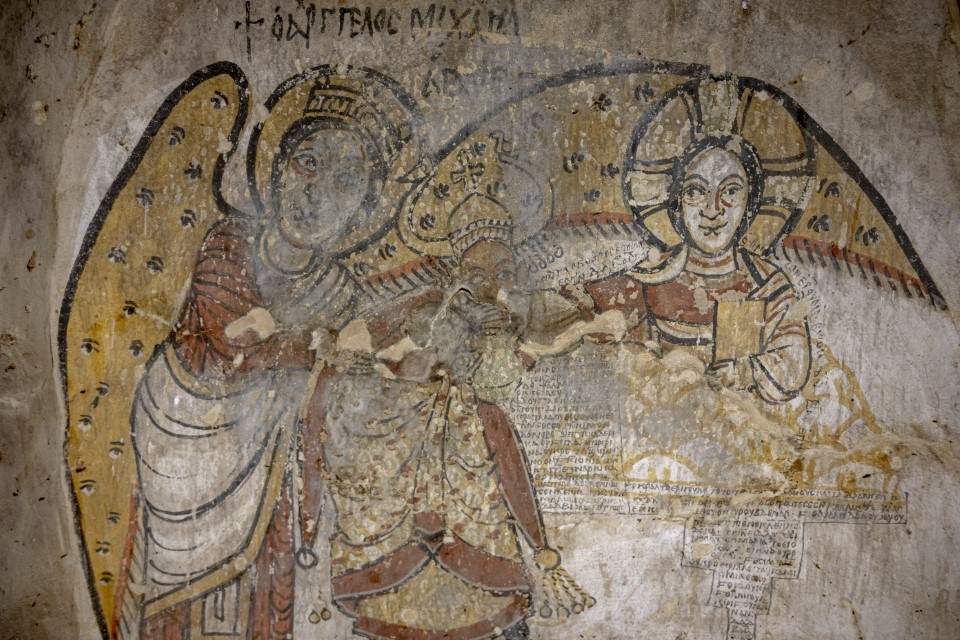Despite the precarious situation in Sudan, a team of Polish archaeologists from the Polish Centre of Mediterranean Archaeology at Warsaw University, led by Professor Kazimierz MichaÅ‚owski, made a major discovery at the site of Dongola (Tungul in ancient Nubian), the capital of Makuria, one of the most important medieval African states, in March (but the news was not released until early April). Indeed, archaeologists Lorenzo De Lellis and Maciej WyżgoÅ‚ unexpectedly stumbled upon an enigmatic complex of rooms made of sun-dried bricks, the interiors of which were covered with figurative scenes believed to be unique to Christian art. The discovery was made while exploring houses dating back to the Funj period (16th-19th centuries). To the researchers’ surprise, there was an opening under the floor of one of the houses that led to a small chamber, the walls of which were decorated with unique depictions. The paintings inside showed the Madonna, Christ, as well as a scene depicting a Nubian king, Christ again, and the archangel Michael.
This is not a typical depiction of a Nubian ruler under the protection of saints or archangels. The king bows to Christ, who is seated in the clouds, and kisses his hand. The ruler is supported by the archangel Michael, whose outstretched wings protect both the king and Christ himself. Such a scene has no known parallels in Nubian painting. Moreover, the dynamism and intimacy of the depiction contrasts with the hieratic nature of the figures depicted on the side walls, nor does the figure of the Virgin on the north wall of the chamber belong to the typical repertoire of depictions of Mary in Nubian art. The mother of God, shown in a dignified pose, is dressed in dark clothing and in her hands holds a cross and a book, while Christ is depicted on the opposite wall. Her right hand is shown in a gesture of blessing, and in her left she holds a book, which has been fragmentarily preserved.
The paintings are accompanied by inscriptions that are currently being studied by Dr. Agata DeptuÅ‚a of the University of Warsaw. A preliminary reading of the Greek inscriptions led to their identification as texts from the Liturgy of the Presanctified Gifts (a Byzantine Lenten rite). Then there is an inscription in ancient Nubian that accompanies the main scene, and which is extremely difficult to decipher: however, thanks to a preliminary reading by Dr. Vincent van Gerven Oei, the researchers learned that it contains several mentions of a king named David and a supplication to God for the city’s protection. The city mentioned in the inscription is probably Dongola, and King David is probably the royal figure depicted in the scene. David was one of the last rulers of Christian Makuria, and the period of his rule marked the beginning of the end of the kingdom. For unknown reasons, King David attacked Egypt, which retaliated by invading Nubia and, as a result, Dongola was sacked for the first time in its history. Perhaps the painting was created as the Mamluk army was approaching the city or was already besieging it?
The biggest enigma, however, is the complex of rooms in which the paintings were found. The rooms themselves, covered by vaults and domes and made of dry brick, are quite small. The room with the painted scene showing King David resembles a crypt, but it is 7 meters above the medieval ground level. The building is adjacent to a sacred building identified as the Great Church of Jesus, which was probably the cathedral of Dongola and the most important church in the kingdom of Makuria. Arab sources recounting King David’s attack on Egypt and capture of the ports of Aidhab and Aswan claim that this act was instigated by the Great Church of Jesus. Did the Archbishop of Dongola, just like Pope Urban II, therefore urge King David to launch a crusade?
Further excavation could provide answers to these and other questions about the enigmatic structure. However, the most important goal of this season has been to preserve the unique wall paintings. Immediately after the discovery, conservators, under the direction of Magdalena SkarżyÅ„ska, set to work. The conservation team worked as part of a cooperation between the Polish Centre of Mediterranean Archaeology, and the Department of Conservation and Restoration of Works of Art at the Warsaw Academy of Fine Arts. Working in such a confined space, under time pressure and with the high temperatures typical of March in Sudan was extremely challenging. The paintings were detached from the walls in places, but the pictorial layer itself was remarkably well preserved. Conservators secured the wall paintings, made protective bands and stucco, and filled the gaps between the wall and plaster with injection fluid. It may be possible to find out whether or not the discovered structure is a real memorial complex when archaeologists from the Polish Center of Mediterranean Archaeology return to Dongola in the fall, assuming the current situation in the country permits. Currently, several of the Center’s projects are underway at the Dongola site. And it is not known if and when they can go forward.
 |
| Sudan, important Christian frescoes discovered, unprecedented for Nubian painting |
Warning: the translation into English of the original Italian article was created using automatic tools. We undertake to review all articles, but we do not guarantee the total absence of inaccuracies in the translation due to the program. You can find the original by clicking on the ITA button. If you find any mistake,please contact us.